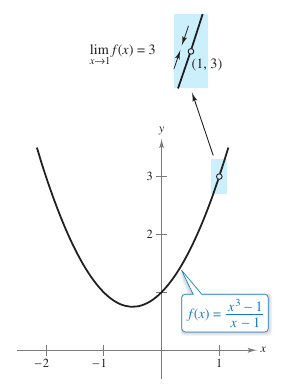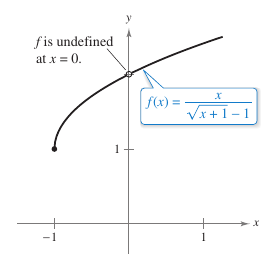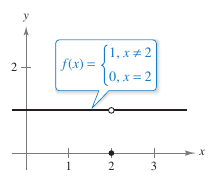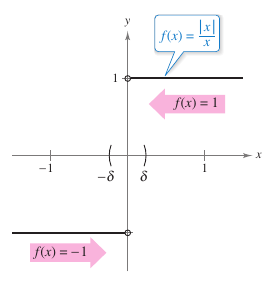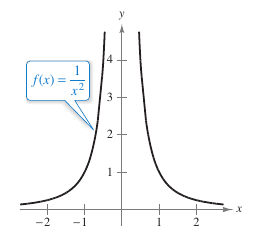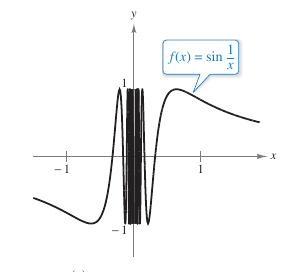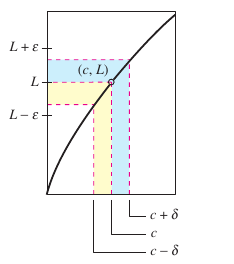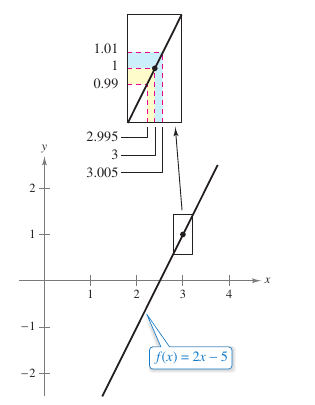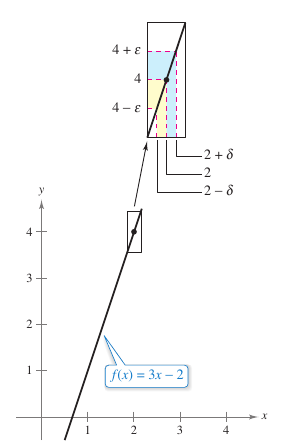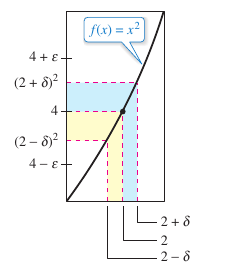Calculus I 01.02 Finding Limits Graphically and Numerically
| Previous | Calculus I 01.01 What is Calculus? |
| Next | Calculus I 01.03 Evaluating Limits Analytically |
Contents
Finding Limits Graphically and Numerically
- Estimate a limit using a numerical or graphical approach.
- Learn why a limit may not exist.
- A formal definition the limit.
An Introduction to Limits
|
|
Sketch the graph for
for values other than \(x=1\). At \(x=1\) the graph's behavior is unknown. Thus the circle in the graph, as shown in Figure 1.2.1. To investigate the graph as it approaches \(x=1\) divide the values for \(x\) into two sets. One approaching from the left and one approaching from the right. As displayed in Table 1.2.1 below.
As \(x\) moves arbitrarily close to 1 the result from \(f(x)\) moves arbitrarily close to 3. Calculus notation expresses this idea below:
An informal definition for the Limit. If \(f(x)\) becomes arbitrarily close to a single number \(L\) as \(x\) approaches \(c\) from either side, then the limit for \(f(x)\) is \(L\). This limit is written as
|
Example 1.2.1 Estimating a Limit Numerically
|
|
Evaluate the function \(f(x)=x/(\sqrt{x+1}-1)\), as shown in Figure 1.2.2, at several \(x\)-values near 0 and use the result to estimate the limit
Solution Table 1.2.2 describes the values for \(f(x)\) for six \(x\)-values near 0.
From the results in Table 1.2.2 the estimated limit is 2. This agrees with the graph for \(f\) in Figure 1.2.2. In Example 1.2.1, note the function is undefined at \(x=0\), and yet \(f(x)\) appears to approach a limit as \(x\) approaches 0. This often happens, and it is important to realize the existence or nonexistence for \(f(x)\) at \(x=c\) has no bearing on the existence of the limit for \(f(x)\) as \(x\) approaches \(c\). |
Example 1.2.2 Finding a Limit
|
|
Find the limit for \(f(x)\) as \(x\) approaches 2, where
Solution Because \(f(x)=1\) for all \(x\) other than \(x=2\), the estimated limit is 1, as shown in Figure 1.2.3. This limit is written as
The fact that \(f(2)=0\) has no bearing on the existence or the limit's value as \(x\) approaches 2. For example, as \(x\) approaches 2, the function
has the same limit as \(f\). In Section 1.2 limits are estimated numerically and graphically. Each approach produces an estimated limit. Section 1.3 describes using analytic techniques for evaluating limits. Throughout the course use this three-pronged approach to solving Calculus problems.
|
Limits That Fail to Exist
The next three examples describes limits that fail to exist.
Example 1.2.3 Different Right and Left Side Behavior
Example 1.2.4 Unbounded Behavior
|
|
Solution Consider the graph for the function displayed in Figure 1.2.5
In Figure 1.2.5 as \(x\) approaches 0 from either the right or the left, \(f(x)\) increases without bound. This mean that \(f(x)\) grows enormously as \(x\)-values get closer and closer to 0. For example, \(f(x)\) will be greater than 100 when \(x\) is within \(\frac{1}{10}\) of 0. That is,
Putting \(f(x)\) over 1,000,000 is done below.
Because \(f(x)\) does not become arbitrarily close to a single number \(L\) as \(x\) approaches 0 the limit does not exist. |
Example 1.2.5 Oscillating Behavior
|
|
Solution Let \(f(x)= \sin \frac{1}{x}\). In Figure 1.2.6 as \(x\) approaches 0 \(f(x)\) oscillates between \(-1\) and 1. Therefore the limit does not exist because no matter how small \(\delta\) becomes, it is possible to choose \(x_1\) and \(x_2\) within \(\delta\) units from 0 such that \(sin(1/x_1=1\) and \(sin(1/x_1=-1\) , as shown in Table 1.2.3.
|
Common Behavior Types Associated with Nonexistent Limits
- \(f(x)\) approaches a different number from the right side to \(c\) than it approaches from the left side.
- \(f(x)\) increases or decreases without bound as \(x\) approaches \(c\).
- \(f(x)\) oscillates between two fixed values as \(x\) approaches \(c\).
There are many other interesting functions that have unusual limit behavior. An often cited one is the Dirichlet function[1]
- $$f(x)=\left\{\begin{matrix} 0,&\text{if } x \text{ is rational}\\ 1,& \text{if } x \text{ is irrational} \end{matrix}\right.$$
Because this function has no limit at any real number \(c\), it is not continuous at any real number \(c\). This is described in greater detail in Section 1.4.
A Formal Definition for the Limit
|
|
Consider the informal definition for limit discussed earlier in this section. If \(f(x)\) becomes arbitrarily close to a single number \(L\) as \(x\) approaches \(c\) from either side, then the limit for \(f(x)\) as \(x\) approaches \(c\) is \(L\), written as
The weakness in this definition is that exact meanings have not been given to two phrases
and
The first person to assign mathematically rigorous meanings to these phrases was Augustin-Louis Cauchy.[2] His \(\boldsymbol {\varepsilon-\delta}\) limit definition is the standard used today. Figure 1.2.8 displays the definition in simplified form. Let \(\epsilon\) (the lowercase Greek letter epsilon) represent a (small) positive number. Then the phrase “\(f(x)\) becomes arbitrarily close to L” means that “\(f(x)\) becomes arbitrarily close to \(L\) ” means that \(f(x)\) lies on the interval \((L-\epsilon,L+\epsilon)\). Using absolute value this can be written as
The phrase “\(x\) approaches \(c\) ” means that there exists a positive number \(\epsilon\) such that \(x\) lies on the interval \((c-\epsilon,c)\) or the interval \((c,c+\epsilon)\). This fact can be concisely expressed by the double inequality
The first inequality
expresses the fact that \(x \neq c\). The second inequality
says that \(x\) is within a distance \(\epsilon\) from \(c\). |
Definition 1.2.1 Formal Definition for the Limit
Let \(f\) be a function defined on an open interval containing \(c\) (except possibly at \(c\)), and let \(L\) be a real number. The statement
- $$ \lim{x \to c} f(x) = L$$
means that for each \(\epsilon > 0\) there exists a \(\epsilon > 0\) such that if
- $$\left | x-c \right | < \epsilon.$$
then
- $$\left | f(x)-L \right | < \epsilon.$$
This means the limit exists and the limit is \(L\). |} Some functions do not have limits as \(x\) approaches \(c\), but those that do cannot have two different limits as \(x\) approaches \(c\). That is, if the limit for a function exists, then the limit is unique. The next three examples describe the \(\varepsilon-\delta\) limit definition in more detail.
Example 1.2.6 Find a \(\delta\) for a Given \(\epsilon\)
|
|
Given the limit
find \(\epsilon\) such that
whenever
Solution Epsilon, \(\epsilon\), is given the value \(\epsilon = 0.01\). To find an appropriate \(\delta\), establish a connection between the absolute values
Notice that
Because the inequality \(\left | (2x-5)-1 \right | < 0.01\) is equivalent to \(2 \left | x-3 \right | < 0.01\), a good starting value is
This choice works because
which implies that
Figure 1.2.9 displays \(f(x)\) for \(x\)-values within \(3(x \neq 3)\) producing values within 0.01 of 1. Example 1.2.6 produces a \(\delta\)-value for a given \(\epsilon\). This does not prove a limit exists. To prove a limit requires finding a \(\delta\) for any \(\epsilon\). Example 1.2.7 describes this in more detail. |
Example 1.2.7 Using the \(\epsilon-\delta\) Limit Definition
|
|
Us the \(\epsilon-\delta\) limit definition to prove that
Solution Show that for each \(\epsilon >0\), there exists a \(\delta > 0\) such that
whenever
Because the choice for \(\delta\) depends on \(\epsilon\) establish a connection between the absolute values \(\left | (3x-2)-4 \right | \) and \(\left | x-2 \right | \).
For a given \(\epsilon > 0\) we'll start with \(\delta=\epsilon/3\). This works because
implies that
Figure 1.2.10 displays the \(x\)-values within \(\delta\) of \(2(x \neq 2)\), the values for \(f(x)\) are within \(\epsilon\) of 4. |
Example 1.2.8 Using the \(\epsilon-\delta\) Limit Definition with a Polynomial Equation
|
|
Use the \(\epsilon-\delta\) Limit Definition to prove that
Solution Show that for each \(\epsilon >0\), there exists a \(\delta >0\) such that
whenever
To find an appropriate \(\delta\), begin with
For all \(x\) in the interval (1,3), \(x+2<5\) and thus \(|\left | x+2 \right |<5\). Letting \(\delta\) be the minimum between \(\epsilon/5\) and 1, it follows that, whenever \(0<\left | x-2 \right |<\delta\) produces
Figure 1.2.11 displays \(x\)-values within \(\delta\) of \(2(x\neq2)\), the values for \(f(x)\) are within \(\epsilon\) of 4. |
Internal Links
Parent Article: Calculus I 01 Limits and Their Properties
